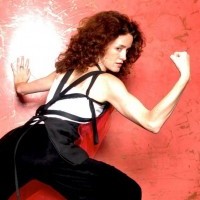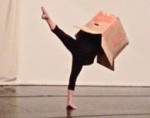
Photo: Paul Hinson
Hold it, control: 12 Questions and Answers
by Carolyn Merritt
In this experimental take on a review, in response to Meg Foley and J. Louise Makary’s experimental show at the Crane Arts Icebox Project Space, TD Editor-in-Chief Lisa Kraus (who was unable to attend) poses 12 questions to writer Carolyn Merritt.
1. The Icebox space is a cavern. How did it look for this show?
Big, empty, white, and long; both pieces were oriented to maximize depth—we entered and immediately sat on the floor for J. Louise Makary’s Drunk & High: A Duet, and then we simply walked to the other end of the space for Meg Foley’s Togetherish.
2. The advance press about the piece talked about the edge of being in control to losing control. Did you see that?
Makary “impose[d] order and choreographic structure to this common experience of letting go,” (being drunk and high), so I’m not sure she intended to convey losing control, and I never sensed that. She and collaborator Michael Vincent Pusey executed simple movements—step hops, tip toe walks, ball changes, a figure that was almost a jazz square—that read as deliberately awkward, even amateur, but in a cultivated way. Perhaps that was Makary communicating being under the influence... There was a sense that they were free floating within the confines of the space—they moved from the far end of the Icebox towards us, bouncing ever so casually off the walls into the center of the room, like lazy pinballs or slow-moving Pac-persons.
3. Were there words?
None in Drunk & High. In Togetherish, the dancers occasionally spoke, to themselves or to one another, often barely audibly.
4. Was there something you've never seen before?
I don’t think I’ve ever seen as many false endings in a dance work as I saw in Togetherish (or moments when closure would have satisfied me). This felt deliberate, part of Foley’s desire to “experiment,” as she announced before the piece. With such wonderful dancers to watch (Eun Jung Choi, Christina Zani, Jung-eun Kim and Drew Kaiser), this wasn’t necessarily a bad thing, though it did make me feel antsy. Once an end is suggested, the idea is in my head; I can’t help but anticipate it.
5. Did you see anything that made you gasp?
There was a wonderful moment in Togetherish, when articles of clothing the dancers had been playing with—pulling and twisting on, in various stages of partial removal, and then apart from their bodies—suddenly appeared in a diagonal that stretched from one corner of the space lengthwise to the opposite. I’d been so intently focused on following the dancers moving through the space, and not the clothing as it dropped. That line delighted me.
6. Were you ever embarrassed during the show?
I wasn’t, but I wondered if others were at one point in Togetherish. The dancers invited audience members into the space with them and several joined, the music became party-ish, and they were all mingling and grooving in what felt like an ending. Suddenly the music stopped, the performers began executing a unison-ish phrase amidst the crowd, and the audience members who’d joined stood in the middle of the space watching. I felt awkward for them. Then the performers began shooing and ushering people back into their seats. It felt a bit like they’d duped us, albeit in a harmless and playful way.
7. Was it PG or R?
R because there was free alcohol before the show, but as far as the content of the works goes, PG or even G (there was at least one toddler in the crowd). In Togetherish, the dancers partially displayed body parts that are often covered—the top of the tailbone, a back, the upper length of a thigh. These moments emerged so naturally in the choreography (or perhaps structured improvisations) that they read less as exposure than a simple extension of the body’s movements into/ through clothing. (They also brought to mind Benetton and Calvin Klein ads—varied skin tones, colorful clothing, hipster aesthetics—though the dancing was much more interesting.) Towards the end of Drunk & High, Makary and Pusey eased into a very brief bump n’ grind. Their faces were blank and the actions utterly removed of any suggestion—the desexualization was oddly troubling.
8. Did you care about the people doing it?
I always care when I watch the choreography of someone I know or performers I know or admire, so I automatically attended differently to Meg Foley’s piece because I know Meg and admire her work, and I can’t gush enough about Eun Jung Choi’s dancing—she shifts from slinky to explosive to subtle so seamlessly, she can do funny, and her body and face are so deeply expressive she seems to grow right in front of you. (Jung-eun Kim and Christina Zani, familiar names, and Drew Kaiser, unknown to me before this, are also technically stellar and generally captivating—cool, commanding, articulate movers fully at home in the experiment.) On the one hand, my expectations are high when I see the work of someone I already admire, but I’m also primed to appreciate what they’re doing because they’ve impressed me in the past. Makary and Pusey were both new to me, and so I think I wanted them to prove themselves somehow. I don’t necessarily have any specific expectations, but something special has to happen to really get my attention. This heightened bar feels unfair, and I try to be aware of it as a viewer.
9. Is there any image from it you will never forget?
The line of clothing in Togetherish (see 4). Also, in another “almost ending” that immediately preceded the real ending, the dancers composed patterns on the walls with black duct tape, and then began extending these tape shapes off the wall out into the space. This could have been a piece unto itself; I would have liked to see how it might develop.
10. How did you feel when you walked out?
Famished.
11. How did the others walking out seem to be feeling?
I didn’t stick around long enough to see (see 10).
12. Do you have any questions for the choreographer?
Both works were billed as “experiments,” so I’d love to know how the choreographers felt about the culminating performances, what the performers learned in the process, how they felt the space influenced each piece, and what other questions they might pose to a reviewer or audience member.
Hold it, control, Meg Foley and J. Louise Makary, Icebox Project Space at Crane Arts, November 12-14.
By Carolyn Merritt
December 8, 2014










